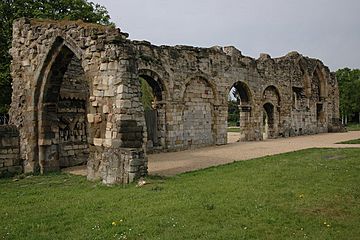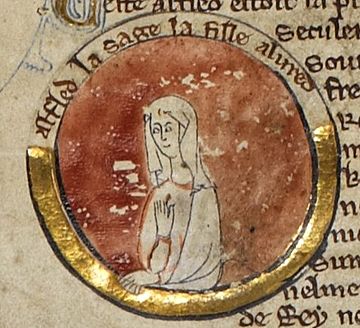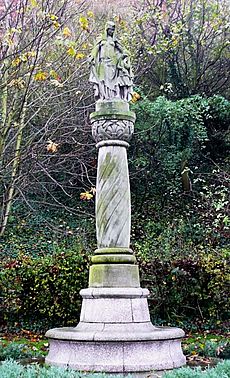Æthelflæd facts for kids
Quick facts for kids Æthelflæd |
|
|---|---|

Æthelflæd (from The Cartulary and Customs of Abingdon Abbey, c. 1220)
|
|
| Lady of the Mercians | |
| Reign | 911–918 AD |
| Predecessor | Æthelred |
| Successor | Ælfwynn |
| Born | c. 870 |
| Died | 12 June 918 Tamworth, Staffordshire |
| Burial | St Oswald's Priory, Gloucester |
| Consort | Æthelred |
| Issue | Ælfwynn |
| House | Wessex |
| Father | Alfred the Great |
| Mother | Ealhswith |
Æthelflæd, also known as the Lady of the Mercians, was a powerful Anglo-Saxon ruler. She governed the kingdom of Mercia in central England from 911 until her death in 918. Born around 870, she was the oldest daughter of Alfred the Great, the famous King of Wessex. Her mother was Ealhswith.
Æthelflæd grew up during the Viking Age, when Viking invaders were attacking England. By 878, most of England was under Danish Viking control. But King Alfred won a big battle at Edington. After this, the western part of Mercia came under the rule of Æthelred. He accepted Alfred as his overall leader. Alfred then called himself "King of the Anglo-Saxons". This meant he ruled all English people not under Viking control. In the mid-880s, Alfred arranged for Æthelflæd to marry Æthelred. This marriage helped to create a strong alliance between Wessex and Mercia.
Æthelred helped fight off new Viking attacks in the 890s. He worked with Æthelflæd's brother, Edward the Elder, who would later become king. Æthelred and Æthelflæd made Worcester stronger. They also gave money to churches in Mercia. They built a new church, called a minster, in Gloucester. Æthelred's health likely got worse around 900. After this, Æthelflæd probably took charge of Mercia's government. Edward became King of the Anglo-Saxons in 899. In 909, he sent an army from Wessex and Mercia to raid the northern Danelaw (Viking-controlled areas). They brought back the remains of a saint, Oswald, to the new minster in Gloucester. Æthelred died in 911. Æthelflæd then became the official ruler of Mercia, known as the Lady of the Mercians. Having a female ruler in Mercia was very unusual for that time.
Alfred had built many fortified towns called burhs. In the 910s, Edward and Æthelflæd continued this work. They built or strengthened defenses in towns like Wednesbury, Bridgnorth, Tamworth, Stafford, Warwick, Chirbury, and Runcorn. In 917, Æthelflæd sent an army to capture Derby. This was the first of the Five Boroughs of the Danelaw to be taken back by the English. Historians call this her greatest victory. In 918, Leicester surrendered to her without a fight. Soon after, Viking leaders in York offered to be loyal to her. But she died on June 12, 918, before she could accept their offer. A few months later, Edward finished taking control of Mercia. Æthelflæd was succeeded by her daughter, Ælfwynn. However, in December, Edward took full control of Mercia and brought Ælfwynn to Wessex.
Historians still discuss if Mercia was truly independent under Æthelred and Æthelflæd. But they all agree that Æthelflæd was a great ruler. She played a very important part in taking back the Danelaw from the Vikings. Old writers, like William of Malmesbury, praised her. He called her "a powerful help to [Edward], the joy of his people, the fear of his enemies, a woman with a great spirit." Some historians compare her to Elizabeth I, saying she was a "wonder to later ages."
Contents
Mercia's History and Viking Attacks
Mercia was a very strong kingdom in southern England during the 700s. It stayed powerful until it lost a big battle to Wessex in 825. After that, Mercia and Wessex became allies. This friendship was important for fighting against the Vikings.
In 865, a large Viking army, called the Great Heathen Army, landed in East Anglia. They used this area as a base for their invasion. The people of East Anglia had to pay the Vikings to leave them alone. The next year, the Vikings invaded Northumbria. They put their own king in charge there. Then they moved into Mercia in 867. King Burgred of Mercia joined with King Æthelred of Wessex and his brother, Alfred, to fight the Vikings. The Vikings avoided a direct fight, and Mercia ended up paying them for peace. The next year, the Vikings conquered East Anglia.
In 874, the Vikings forced King Burgred out of Mercia. Ceolwulf became the last King of Mercia with Viking support. In 877, the Vikings divided Mercia. They took the eastern parts for themselves. They let Ceolwulf keep the western parts. Some old writings called him a "foolish king's thegn" (a noble) who was controlled by the Vikings. But some historians think he was accepted as a true king by the Mercians and by King Alfred. The situation changed in 878 when Alfred won a major victory against the Danes at the Battle of Edington.
Ceolwulf is not mentioned after 879. Æthelflæd's husband, Æthelred, became the ruler of the English western part of Mercia. He is first mentioned in 881. In 883, he made an agreement with King Alfred's approval. This showed he accepted Alfred as his lord. In 886, Alfred took control of London, which had been held by Vikings. He then gave control of London to Æthelred. In the 890s, Æthelred and Edward, Alfred's son, fought off more Viking attacks. Alfred died in 899. Edward's claim to the throne was challenged by his cousin, Æthelwold. Æthelwold joined forces with the Vikings. His rebellion ended when he died in battle in 902.
Æthelflæd's Family Life
Æthelflæd was born around 870. She was the oldest child of King Alfred the Great and his wife, Ealhswith. Ealhswith was from Mercia. Her father was Æthelred Mucel, a leader of one of Mercia's tribes. Ealhswith's mother, Eadburh, was from the Mercian royal family. This meant Æthelflæd was half-Mercian. Her marriage to Æthelred, Lord of the Mercians, strengthened the link between Wessex and Mercia.
Æthelflæd and Æthelred are mentioned in Alfred's will, written around the 880s. Æthelflæd, called "my eldest daughter," received land and money. Æthelred received a valuable sword. Æthelflæd is first recorded as Æthelred's wife in 887. They had one known child, a daughter named Ælfwynn. Æthelstan, Edward the Elder's oldest son and future King of England, grew up in their home. He likely joined them in their fights against the Vikings.
We don't know much about Æthelred's family background. Some historians think he might have been related to King Alfred's father-in-law. Others suggest he might have been the son of King Burgred of Mercia. If so, he would have been Alfred's nephew, making his marriage to Æthelflæd a marriage between first cousins. This would have been forbidden by church law at the time.
Working with Æthelred
Compared to other parts of England, much of English Mercia was quite peaceful during the Viking Age. It did not suffer many major attacks. Mercian learning was highly respected in the courts of Alfred and Edward. Worcester and Gloucester became important centers for a Mercian revival. Æthelred and Æthelflæd supported this by giving money to churches. In 883, Æthelred gave special rights to Berkeley Abbey. In the 890s, he and Æthelflæd gave a charter to the church of Worcester. This was the only time they are known to have acted together during Alfred's lifetime. Usually, Æthelred acted alone, with Alfred's permission.

In 901, Æthelflæd and Æthelred gave land and a golden cup to the church at Much Wenlock. They also fortified Worcester with King Alfred's permission. They gave the church of Worcester half of the rights to rule the city. This included land rents and money from justice. In return, the church agreed to pray for them daily. In 904, the bishop of Worcester leased valuable land in the city to Æthelred, Æthelflæd, and their daughter Ælfwynn. This land included most of the city's riverfront. This allowed the Mercian rulers to control and profit from the city.
Æthelred's health probably got worse after Alfred died in 899. Æthelflæd may have become the real ruler of Mercia by 902. Some stories say that Norse (Norwegian) Vikings were forced out of Dublin. They then asked Æthelflæd, since her husband was ill, for permission to settle near Chester. Æthelflæd agreed, and for a while, they were peaceful. Later, these Norse Vikings joined with Danes to attack Chester. But the attack failed because Æthelflæd had fortified the town. She and her husband also convinced the Irish among the attackers to switch sides. Other records confirm that Norse Vikings were driven from Dublin in 902. They also confirm that Æthelflæd strengthened Chester in 907. She rebuilt Chester as a burh (fortified town). She improved its old Roman defenses.
In 909, Edward sent an army from Wessex and Mercia to raid the northern Danelaw. They raided for five weeks. The remains of the royal Northumbrian saint Oswald were taken from Bardney Abbey to Gloucester. In the late 800s, Gloucester had become a burh. Æthelred and Æthelflæd had repaired its old Roman defenses. The Mercian rulers built a new minster (church) in Gloucester. It was small but beautifully decorated. It was first dedicated to St Peter. But when Oswald's remains arrived in 909, Æthelflæd had them moved to the new minster. It was then renamed St Oswald's in his honor. This made the church very important. Oswald was a key saint in early Anglo-Saxon Christianity. Æthelred and Æthelflæd were buried in St Oswald's Minster.
Mercia had a long history of honoring royal saints. Æthelred and Æthelflæd strongly supported this. They believed saintly relics gave rulers special power. Æthelflæd likely founded or rebuilt Chester Minster. She also moved the remains of Saint Werburgh there. She might have also moved the relics of Ealhmund from Derby to Shrewsbury. In 910, the Danes attacked Mercia in revenge for the English raid. They reached Bridgnorth. On their way back, an English army caught them in Staffordshire. Their army was destroyed at the Battle of Tettenhall. This opened the way for the English to take back the Danish Midlands and East Anglia.
Lady of the Mercians
When her husband died in 911, Æthelflæd became Myrcna hlædige, which means "Lady of the Mercians". This was the only time a woman ruled a kingdom in Anglo-Saxon history. It was a very unique event for the early medieval period. In Wessex, royal women were not allowed to play political roles. Alfred's wife, for example, was not called queen. But in Mercia, Alfred's sister Æthelswith had been queen. She had signed charters and made grants. Æthelflæd benefited from Mercia's tradition of important queens. This allowed her to play a key role in the early 900s as Lady of the Mercians. This would not have been possible in Wessex.
When Æthelred died, Edward took control of London and Oxford. Alfred had placed these Mercian towns under Mercian rule. Some historians believe Æthelflæd accepted this loss of land. In return, her brother recognized her position in Mercia. Alfred had built many fortified towns in Wessex. Edward and Æthelflæd now started a plan to expand these. They wanted to strengthen their defenses and create bases to attack the Vikings. Historians say Æthelflæd led Mercian armies on planned expeditions. Her leadership in Mercia allowed her brother to begin his push against the southern Danes.
Æthelflæd had already fortified a place called Bremesburh in 910. In 912, she built defenses at Bridgnorth. This protected a crossing of the River Severn. In 913, she built forts at Tamworth to guard against the Danes in Leicester. She also built forts in Stafford to control access from the Trent Valley. In 914, a Mercian army from Gloucester and Hereford stopped a Viking invasion from Brittany. The old Iron Age Eddisbury hill fort was repaired. This protected against invasions from Northumbria or Cheshire. Warwick was also fortified to protect against the Leicester Danes. In 915, Chirbury was fortified to guard a route from Wales. Runcorn was fortified on the River Mersey. Defenses were also built before 914 at Hereford, and probably Shrewsbury.
In 917, three Viking armies tried to invade but failed. Æthelflæd sent an army that captured Derby and the land around it. Derby was one of the Five Boroughs of the Danelaw. The others were Leicester, Lincoln, Nottingham, and Stamford. Derby was the first to fall to the English. Æthelflæd lost "four of her thegns who were dear to her" in the battle. Historians call this victory her greatest triumph. At the end of the year, the East Anglian Danes surrendered to Edward. In early 918, Æthelflæd took control of Leicester without a fight. Most of the local Danish army surrendered to her. A few months later, the leaders of Danish-ruled York offered to be loyal to Æthelflæd. They probably wanted her help against Norse raiders from Ireland. But she died on June 12, 918, before she could take advantage of the offer.
Little is known about Æthelflæd's relations with the Welsh. In 916, she sent an expedition to get revenge for the murder of a Mercian abbot. Her men destroyed a royal fort in Wales and captured the queen and 33 of her companions. After Æthelflæd's death, Welsh kings sought Edward as their lord. This suggests that the Welsh kingdoms were under Mercian rule until Edward took direct control of Mercia.
No coins were made with Æthelred's or Æthelflæd's names on them. But in the 910s, silver pennies were minted in west Mercian towns. They had unusual designs. This might have shown Æthelflæd's wish to make her coins different from her brother's. After her death, west Mercian coins looked the same as those from Wessex again.
Death and What Happened Next

Æthelflæd died in Tamworth on June 12, 918. Her body was carried about 75 miles (120 km) to Gloucester. She was buried with her husband in their church, St Oswald's Minster. Archaeologists have found a building suitable for a royal tomb at the east end of the church. This might have been St Oswald's burial place. Being buried next to the saint would have been a very honorable spot for Æthelred and Æthelflæd.
The choice of burial place was important. If Æthelflæd had chosen Edward's royal tomb in Winchester, it would have shown Mercia was less important. But a traditional Mercian royal burial place would have been a strong statement of independence. Gloucester, near the border with Wessex, was a good compromise.
Æthelflæd died a few months before Edward finished taking control of the southern Danelaw. Her daughter, Ælfwynn, became Lady of the Mercians. But in early December 918, Edward removed Ælfwynn from power. He took Mercia under his own control. Many Mercians did not like their old kingdom being ruled by Wessex. Edward died in 924 after putting down a rebellion by Mercians and Welshmen in Chester.
Her Legacy
To the Wessex version of the Anglo-Saxon Chronicle, Æthelflæd was just King Edward's sister. But for the Mercian Register, she was the Lady of the Mercians. Irish and Welsh records called her a queen. The Annals of Ulster even called her famosissima regina Saxonum (renowned Saxon queen). Anglo-Norman historians also praised her. Henry of Huntingdon wrote a poem about her, calling her "Heroic Elflede! great in martial fame, A man in valour, woman though in name."

Some historians believe Æthelred and Æthelflæd were independent rulers. They point out that she was called "Lady" or "Queen," which suggests she had royal power. One historian described Æthelflæd as "the last Mercian queen." She is mentioned in charters as "by the gift of Christ's mercy ruling the government of the Mercians." Historians argue that Æthelred and Æthelflæd had most of the powers of a monarch after Alfred's death. But it would have been risky to formally claim to be king or queen. Some see her as a "warrior queen," like Elizabeth I.
One historian, Charles Insley, said: "The idea that Mercia was somehow waiting to be joined into 'England' is wrong. Æthelred's death in 911 changed little, because his strong wife continued as the sole ruler of Mercia until her death in 918. Only then did Mercia's independent life end."
Other historians believe Æthelflæd willingly accepted a lesser role in a partnership with her brother. They think she agreed to his plan to unite Wessex and Mercia. Edward might have sent his oldest son, Æthelstan, to be raised in Mercia. This would make him more acceptable to the Mercians as king. Æthelflæd does not seem to have tried to find a husband for her daughter. Her daughter would have been almost 30 by 918. Some historians think West Saxon records ignored Æthelflæd's achievements. They feared that recognizing her might encourage Mercian independence.
All coins were made in Edward's name. While Mercian rulers could issue some charters on their own, others showed Edward's lordship. One charter from 903 says a Mercian leader "asked King Edward, and also Æthelred and Æthelflæd, who then held rule and power over the Mercians under the said king." This suggests that Mercia was under Edward's rule from the start of his reign. However, Æthelflæd and Æthelred did much to encourage a separate Mercian identity. They created special religious sites for Mercian saints in their new fortified towns.
Commemoration
In June 2018, Æthelflæd's funeral was re-enacted in Gloucester. About 10,000 people watched this event. It was part of celebrations for the 1,100th anniversary of her death.

The 1,100th anniversary of Æthelflæd's death was celebrated throughout 2018 in Tamworth. Events included the unveiling of a new six-meter statue. There was also a large community art project. A special church service, talks, and guided walks took place. A special beer was even brewed. An academic conference brought scholars from all over the world.
See also
 In Spanish: Ethelfleda de Wessex para niños
In Spanish: Ethelfleda de Wessex para niños


